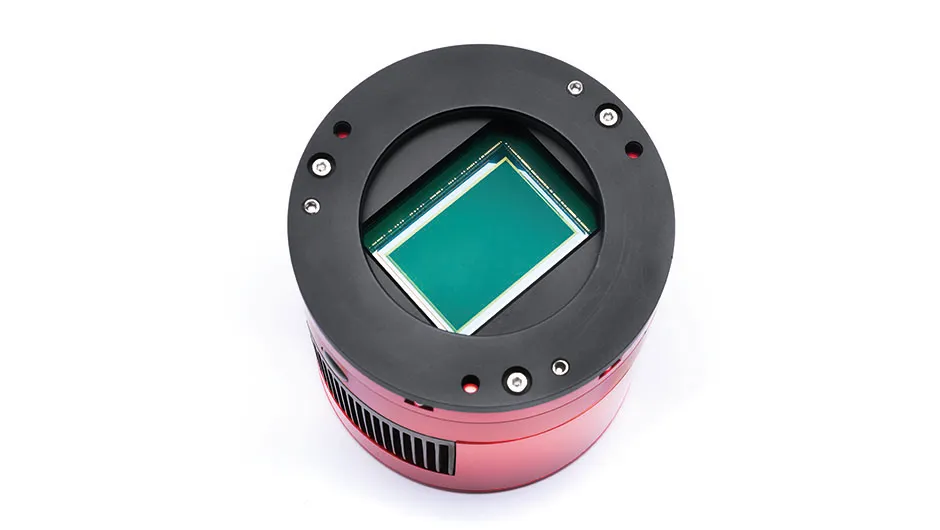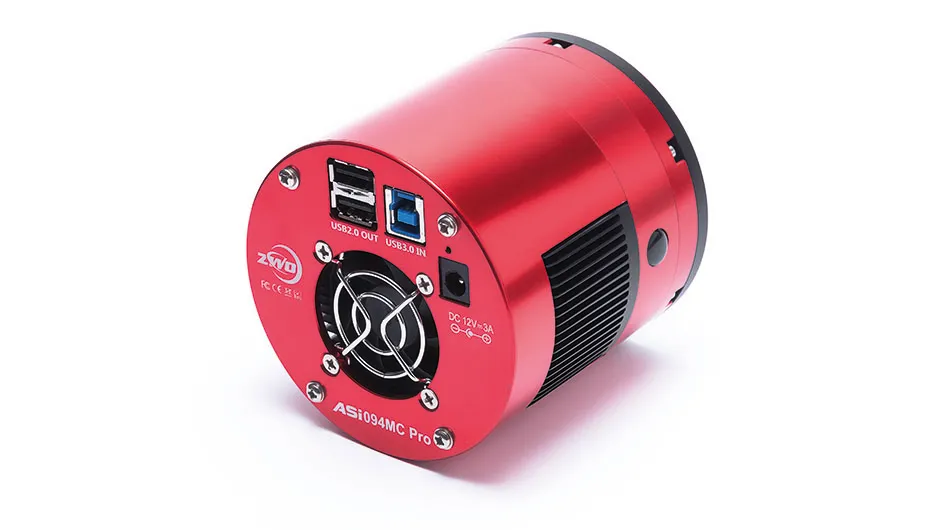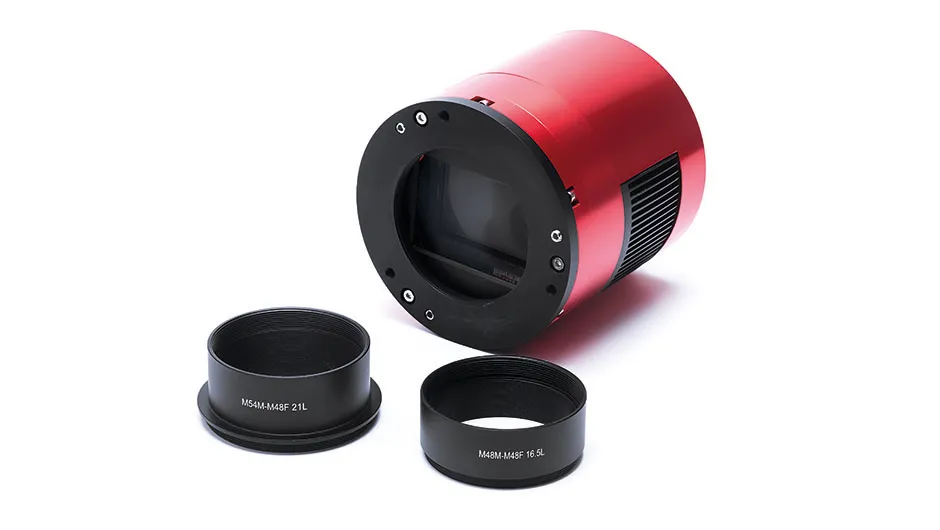Price: £3680.00
Weight: 640g
Supplier: 365 Astronomy
Telephone: 0203 384 5187
Website: www.365astronomy.com
ZWO has been around for quite a long time now and has been pushing the boundaries of CMOS camera capabilities with every new model.
On paper, its latest camera looks to push those boundaries to a whole new level.
The ZWO ASI094MC Pro cooled full-frame camera has some impressive specifications and hefty price tag to match.
This is the first full-frame camera for ZWO so we were eager to get imaging with it.
Inside the box, the camera arrives in its own padded carry bag and comes with quite a few accessories.
It shares the same cylindrical shape as other cooled cameras in the ZWO range.
Taking the cap off the camera reveals a formidable-sized sensor measuring 36x24mm, g iving a diagonal measurement of 43mm.
On the back of the camera there’s a dual USB3 and USB2 port along with two USB2 ports that act as a hub for accessories such as motor focusers and filter wheels.
There’s also a 12V socket for the cooler, though there’s no power supply included with the camera.

It would have been nice to see one in the box considering the price ZWO is charging.
After downloading the driver package the camera was ready to go.
On the first clear night the Moon was quite bright, so we gave the camera a run in video mode.
Setting the camera up on a 5-inch refractor with an 800mm extension tube it was easy to resolve a good image of the Moon on screen.
The maximum speed of the camera in full- frame is 5FPS and, setting a capture of 200 frames, it didn’t take too long for the SER video file to download.
You can can increase the speed of the camera considerably by changing the region of interest (ROI) settings.
Sensor sensibility
With Mars being low and in the midst of its dust storm it was hard to resolve detail, but the results did show that the camera can be a bit of an all-rounder at imaging.
A few nights later we switched over to an f/2.2 Rowe-Ackermann Schmidt Astrograph (RASA) telescope.
In full frame mode the camera will run outside the imaging circle on this type of setup and create vignetting, so it gave us a good chance to try the ROI modes.

The first target was the Whirlpool Galaxy, M51, running 30-second exposures with the cooling set to –30° below ambient temperature.
The camera performed very well, not dropping any frames when capturing in high bit mode.
We moved through a few targets including M13, the Great Globular Cluster in Hercules, and M27, the Dumbbell Nebula.
In full-frame mode the camera is best suited to an aperture of around 70-100mm, so we set the camera up on a 70mm quad refractor for the next outing, going for wide-field targets like the North America Nebula.
Setting longer exposure times of 180 seconds worked very well.
There was no amp glow in the images in USB2 mode, even when connected via 10m USB2 extension leads, and this made processing with calibration frames very easy.
Setting up with a 152mm triplet we took a chance on M31, the Andromeda Galaxy, which was rising in the north against a bit of a light blue summer night sky.
Running in full-frame at 60 second exposures for 50 minutes resolved lots of nice detail in the dust lanes and the core.
When we processed the images, it was nice to see some rich colours from a CMOS camera.
The ZWO may have an expensive price tag, but it really is a great performer.

Outstanding feature: Tuned-up Sony IMX094 Exmor sensor
Sony’s IMX094 Exmor sensor is already very good and ZWO has tuned it to get the best performance.
In full frame mode the resolution is 36MP (7,376x4,928) with a pixel size of 4.88µm.
A read noise of 2.1e @24db gain makes the camera very sensitive, so that fine detail resolves well in images of targets like M51, the Whirlpool Galaxy; being able to capture the rear dust lanes in short exposures was a real treat.
The rich and vibrant colours captured in the images make it a joy to use.
The front glass is IR coated and seems to have an antistatic treatment as it stayed clean all through testing.
The Bayer matrix is set at RGGB, though some capture software can flip this reading, so it may have to be set to BGRG in processing to attain the correct colours.
In ROI mode for deep-sky imaging it’s one of the first CMOS sensors to show no banding in the background of the images.
This, along with its ability to switch to planetary imaging, makes this camera a really good tool for any astro imager.

Tilt adaptor
On the front casing is a built-in tilt adaptor for aligning the sensor to the optical train.
A set of push and pull screws makes adjustments easy.
The tilt adaptor can be used to counter any sag in a focuser that may cause distortion in the image.
Heated front glass
Behind the protective glass of the sensor is a built-in heater.
Because of the size of the glass, the heater is needed to stop dew forming on the glass inside or out when the TEC cooler is running.
It can be adjusted in the capture software.
Cooling
A two-stage thermoelectric cooler is built in to the camera, allowing the temperature to be regulated to between –30° and –35° below ambient using the capture software.
In the body of the camera is a built-in heat sink and on the rear is a MagLev fan.
USB sockets
A range of USB sockets on the back of the camera allow connection to a multitude of equipment.
The combined USB2 and USB3 socket can be connected to an external hub to allow for use of longer cables than the one supplied.
Having a dual USB2 hub also cuts down on the amount of cables running to and from the camera.
Spacers
M48 adaptors are included with the camera in two sizes.
The 21mm and 16.5mm adaptors, combined with the back focus of the sensor round up to 55mm.
This is suitable for imaging systems like the RASA and imaging setups using reducers.
It makes it really easy to use with no guessing.
This review originally appeared in the September 2018 issue of BBC Sky at Night Magazine